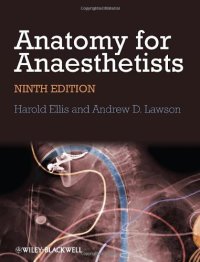
Ebook: Anatomy for Anaesthetists
Author: Harold Ellis Andrew Lawson
- Genre: Medicine // Anatomy and physiology
- Tags: Internal Medicine Cardiovascular Dermatology Diseases Disorders Endocrinology Gastroenterology Geriatrics Gynaecology Obstetrics Haematology Neurology Clinical Neurophysiology Ophthalmology Otorhinolaryngology Paediatrics Renal Respiratory Rheumatology Urology Medical Healthcare Practitioners Health Family Lifestyle Anaesthesia Nursing Anaesthetics Other Branches of Pre clinical Sciences A Z Science Nature Anatomy Basic Scientific Technical Orthopaedic Fractures Pathology Psychiatry Public Preve
- Year: 2013
- Publisher: Wiley-Blackwell
- Edition: 9th Edition
- Language: English
- pdf
Jubilee edition of the classic text first published in 1963
Anaesthetists require a particularly specialized knowledge of anatomy.
The anaesthetist must know intimately the respiratory passages, the major veins and the peripheral
nerves to deliver safe and effective pain control.
As one of the great teachers of anatomy, Professor Harold Ellis is eminently qualified to elegantly
provide the anatomical detail required of anaesthetists. Modern approaches to practice, including
the use of imaging to guide anaesthetic practice, add further depth to the fine full-colour anatomical
illustrations.
Designed for anaesthetists, Anatomy for Anaesthetists covers:
• The Respiratory Pathway, Lungs, Thoracic Wall and Diaphragm
• The Heart and Great Veins of the Neck
• The Peripheral Nerves
• The Autonomic Nervous System
• The Cranial Nerves
• The Anatomy of Pain
Clinical Notes throughout provide the clinical context for the anatomical detail. Designed for trainees, but of continuing relevance to practicing anaesthetists, and now in its Golden Jubilee edition, Anatomy for Anaesthetists provides a central pillar of anaesthetic knowledge.
Anaesthetists require a particularly specialized knowledge of anatomy.
The anaesthetist must know intimately the respiratory passages, the major veins and the peripheral
nerves to deliver safe and effective pain control.
As one of the great teachers of anatomy, Professor Harold Ellis is eminently qualified to elegantly
provide the anatomical detail required of anaesthetists. Modern approaches to practice, including
the use of imaging to guide anaesthetic practice, add further depth to the fine full-colour anatomical
illustrations.
Designed for anaesthetists, Anatomy for Anaesthetists covers:
• The Respiratory Pathway, Lungs, Thoracic Wall and Diaphragm
• The Heart and Great Veins of the Neck
• The Peripheral Nerves
• The Autonomic Nervous System
• The Cranial Nerves
• The Anatomy of Pain
Clinical Notes throughout provide the clinical context for the anatomical detail. Designed for trainees, but of continuing relevance to practicing anaesthetists, and now in its Golden Jubilee edition, Anatomy for Anaesthetists provides a central pillar of anaesthetic knowledge.
Download the book Anatomy for Anaesthetists for free or read online
Continue reading on any device:

Last viewed books
Related books
{related-news}
Comments (0)